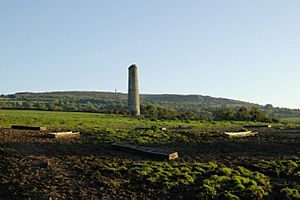Luckett, Cornwall facts for kids
Luckett is a small, quiet place called a hamlet in the eastern part of Cornwall, England. It's located in an area that used to be very busy with mining. Luckett sits right next to the River Tamar, about 5 kilometers (3 miles) north of a town called Callington. In 2011, the number of people living in Luckett was counted as part of the nearby area of Stokeclimsland.
Contents
Luckett: A Small Place with a Big History
Luckett is a fascinating place with a long past, even though it's quite small today. It's known for its history connected to mining and its beautiful natural surroundings.
Where is Luckett?
Luckett is found in the beautiful county of Cornwall, which is in the southwest of England. It's close to the border with Devon, with the River Tamar flowing nearby. This river forms a natural boundary between the two counties. Being near the river and in a former mining area means the landscape around Luckett has a unique look.
What is a Hamlet?
You might be wondering what a "hamlet" is. It's a very small settlement, even smaller than a village. Hamlets usually don't have a church or a large main street. They are often just a cluster of houses and a few buildings. Luckett is a great example of a traditional English hamlet.
Luckett's Past: From Deer Park to Mining Area
Hundreds of years ago, Luckett was part of something very grand. In the 12th century, it became part of a special hunting ground called a royal deer park. This park was named Kerrybullock. Kings and queens would use these parks for hunting deer.
However, this changed in the early 16th century. King Henry VIII decided that the park was no longer needed for deer hunting. So, he "disparked" it, meaning it stopped being a royal deer park. After this, the area around Luckett became important for mining. People dug for valuable metals like tin and copper, which were very common in Cornwall.
Protecting Nature: Greenscoombe Wood SSSI
South of Luckett, there's a very special natural area called Greenscoombe Wood, Luckett SSSI. SSSI stands for Site of Special Scientific Interest. These are places chosen because they have rare or important plants, animals, or geological features.
Greenscoombe Wood is important because of its amazing biological interest. This means it's home to many different kinds of plants and animals that need to be protected. It's a great example of how nature can thrive, even in areas with a history of human activity like mining.


